The first story is about curry.
“It’s an Indian food!”
I thank you all for your “Indian food”. Thank you.
I wanted that response.
Of course, as long as I am writing a column, I will answer “No” to that question.
What I mean by curry here is “Japanese-style curry.
I recently heard that in recent years, “Japanese Curry” has become the No. 1 popular dish in travel destinations around the world.
So, although it is already known to many people, this article is for those who do not yet know about it and for those who want to taste a higher level of Japanese Curry.
Japanese curry and Indian, Sri Lankan, and Nepalese curry share the same spicy flavor, but they are actually quite different.
Of course, there are differences between Indian, Sri Lankan, Nepalese, and Pakistani curries, but they are nothing compared to each other.
In fact, if you say to an Indian person, “We have curry in Japan, too,” you may be offended.
In Japan, curry is so popular that it is considered “a national dish”.
It is not uncommon for middle-aged people to get excited when they hear the words, “Curry is coming tonight”.
There are many the salty snacks with curry-flavored.
It is a popular menu item served at home and at school lunches, so it has been tamed since childhood.
In fact, several percent of the Japanese subconscious may be dominated by curry.
For example,
The second product in the history of Cup Noodles, which everyone is familiar with, is curry-flavored.
There are also other “recommended” curry-flavored snacks at our local convenience store.
(Other recommended “curry-flavored dishes that are not curry” are listed at the end of this article.)
There are restaurant chains that sell only curry,
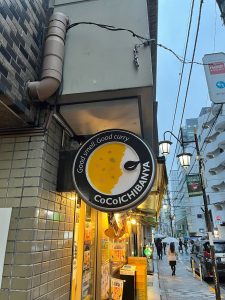
and there are food companies whose main product is curry.

Copyright (c) House Foods Corp.
I’m getting tired of writing about them.
In other words, this means that there is tremendous competition.
Therefore, restaurants that go out of their way to charge money for curry must be of very high quality in order to be highly rated.
Let me introduce some of the best curry restaurants.
Attention!
If you go at lunchtime, it will be very crowded, so go before 12:00 or after 1:00 p.m., and you will be able to get in relatively easily.
New Castle (Ginza Station)
この投稿をInstagramで見る
Google: https://maps.app.goo.gl/8Mrcygn7NhPvmV5UA
Tabelog: https://tabelog.com/tokyo/A1301/A130101/13002424/
In my opinion, this is the best Japanese-style curry among Japanese-style curries.
It is a top compatible curry with the curry that Japanese people are used to at home.
It is usually topped with a fried egg.
Stone (Asakusabashi Station)
この投稿をInstagramで見る
Google: https://g.co/kgs/4bLxJpo
Tabelog: https://tabelog.com/tokyo/A1311/A131103/13031461/
It’s hot. Just hot. (Hot doesn’t mean spicy, it’s about temperature.)
Be careful not to burn yourself.
And the ingredients are pretty cheap. However, it’s good! Somehow, it tastes unusually good. What is going on here?
Sapporo Dominican (Ginza Station)
この投稿をInstagramで見る
Google: https://g.co/kgs/ZcEPqYL
Tabelog: https://tabelog.com/tokyo/A1302/A130202/13025381/
Let me introduce you to a slightly different kind of curry restaurant.
Sapporo is famous for its soup curry.
This curry is quite watery, which is unusual for a Japanese curry.
The reason for this is explained later, but Japanese curry is basically a thick soup.
However, it is very tasty, spicy, and full of flavor.
Note that it is soup, so it splashes easily. You must be brave or very stupid to go there in a white shirt. I repeat. Don’t go out to eat in a white shirt.
Curry no Toriko (Kanda Station)
この投稿をInstagramで見る
Google: https://g.co/kgs/etVdn11
Tabelog: https://tabelog.com/tokyo/A1310/A131002/13224725/
This curry shop is a bit different.
It does not resemble any other restaurant. But it is addictive. It is addictive.
The owner of the restaurant seems to be quite an eccentric and is very particular about etiquette.You can’t make a fuss in this restaurant. Concentrate on the curry. It’s like Zen.
(Once, the owner was wearing a T-shirt that said, “I’m a communication failure and asshole”.)
If you can go there in winter, you should try the restaurant’s limited menu, mackerel miso curry.(Mackerel miso is called saba-miso. It is stewed mackerel with miso, sake and sugar.)
The mackerel stewed in a slightly sweet miso flavor gives it a deep taste. You may be enlightened.
Incidentally, mackerel miso is a standard Japanese side dish, very popular and sold in cans.
As an extra, let me introduce some reasonably priced chain restaurants.
Coco Ichibanya
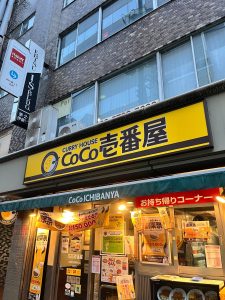
As is well known, this is the largest curry chain in Japan. There is usually one in larger towns.
The spiciness can be adjusted up to 10 levels,
“Hey, you little punk! Don’t go up to 10. Don’t go for 10 unless you want to sweat like Niagara!”
For those who are good with spicy food, I recommend around 3.
The soup, by the way, is pork-based. However, non-pork-based soups (vegetable-based and beef-based) are also available, so just let them know what you want and you will be fine. There are a few restaurants that specialize in halal food, but the number is very small.
Matsuya

Matsuya is a beef bowl (It’s called Gyu-don.) restaurant, but they have a menu called “Karegyu” which has many fans, so I will introduce it here.
>Incidentally, I don’t like it very much because it is a little oily.
I will explain about Gyu-don another time.
Some notes and advice
The basic structure of Japanese curry is like this. The white “rakkyo” or reddish-brown “fukujinzuke” on the side is a sweet pickle, so take a bite of it between spicy curries.
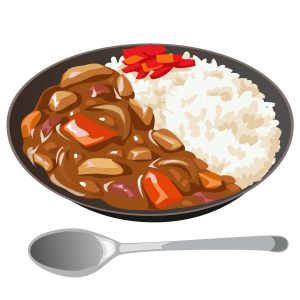
standard curry style
The most common ingredients are chicken, beef, pork, and seafood (especially shrimp and squid, but not fish).
If there is a spiciness adjustment, don’t get carried away. Some restaurants are no longer spicy but painful.
Curry in Japan is basically eaten with rice. If a restaurant has naan, it is basically an Indian curry restaurant.
Incidentally, the history of curry in Japan is surprisingly old. It was even used as a rationed food for the Navy in the Meiji era (19th century), so it has been around for more than 100 years.
The recipe did not come directly from India to Japan, but was apparently passed through England.
So, the major differences from India are as follows,
- Spices are more limited and softer than in India.
- the presence of fried flour (this is the reason for the thickening)
- In some cases, it contains seafood broth (although this is also found in some regions in India).
Extras
A little information about “curry dishes” instead of curry.
There are many “curry-flavored” dishes, but here are a few that have reached the point of perfection.
Curry bread
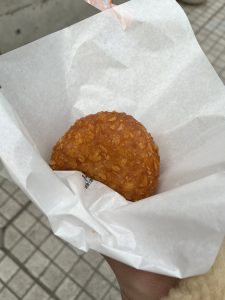
In addition to plain bread and baguettes, there is a genre of “side dish bread” in Japan. Side dishes are side dishes that are eaten on a daily basis. These are often served inside or on top of the bread.
There are so many variations that I will write about them in another article.
Among them, this curry bread is one of the top five most popular breads in Japan.
There was a Japanese TV program that ran an experiment to see what would happen if a curry bread stall was opened in India. What would happen if you opened a curry bread stall in India?
The result was Indian people on the street said, “What is this? Delicious!”.
It is a deep-fried bread wrapped a thicker curry, which is a more simmered version of the usual curry.
It is hearty, crispy on the outside, and unmistakably savory.
The combination of the lightness of the bread, the rich, sticky curry, and the oiliness of the deep-fried bread gives an indescribably satisfying sensation.
It is sold at convenience stores, but the easiest and most recommended is the curry bread sold in front of the cash register at 7-Eleven, which is prepared at each store.
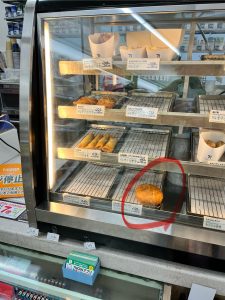
Curry Soba or Udon Noodles
Have you ever heard of soba or udon?
Soba is not a galette in Japan, but a noodle made from buckwheat, and both the name of the crop and its processed noodles are called “soba” in Japan.
However, some ramen noodles are also called “Chuka soba (meaning Chinese noodles)”. It’s complicated.
Soba” can refer to noodles or the name of the crop itself.
Udon is a noodle made of wheat.
この投稿をInstagramで見る
The photo shows “Seri Curry Soba” at Ginza Taimeian, which is an excellent curry soba. (Seri is like a Japanese herb, and is good season in winter. The root part is the most delicious.)
In other words, both soba and udon are noodles, but there are menus whose soup is curry.
Curry goes well with grains, so this is also very tasty.
What makes it different from regular curry is that it has a strong seafood-based broth and is customized for noodles.
There is one caveat, however.
The soup flies. The yellow, unwashable soup flies a lot.
In Japan, “the guy who wears white and eats curry udon” is almost like saying, “I have some balls or I am just a big asshole. I recommend wearing black when eating.
The cheapest and easiest way to eat is
You should be able to find it easily by looking for a chain restaurant called Nadai Fuji Soba.
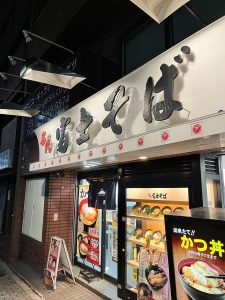
To be honest, it is not a very good soba restaurant, but you should be able to get a standard taste.
>Soba is buckwheat noodles, a menu with a very long and deep history in Kanto (Tokyo and other regions) and Nagano, which I would like to explain sometime. I would like to explain it someday. After all, it is my favorite food and there are as many restaurants as there are stars in the sky.
>Incidentally, udon is the major dish in the Kansai region (centering on Osaka and Kyoto), while soba is the major dish in the Kanto region. Do not eat soba in the Kansai region, as you will get into trouble (it is not tasty).
Last but not least
For those who want to make Japanese Curry at home. It’s very easy!
Each family has its own taste, but I would like to introduce a curry that was introduced on TV and is made by a professional cooker family.
I tried making it myself, and it is “THE Japanese Family Curry”.
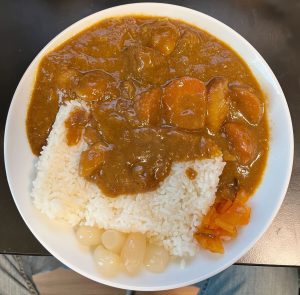
Material
- The main roux S&B’s Dinner Curry (middle) → Important
- Two kinds of other curry roux (other than S&B’s. For example. House Foods, Ebara Foods, Glico, etc.)
- (for example)House Prime Java Curry (Hot)
- (for example)ZEPPIN Glico Curry (Medium Hot)
- (for example)Ebara Yokohama Hakuraitei Curry Flake BLACK Dry (Hot)
- 4 potatoes
- 2 onions
- 1 bay leaf
- 1 carrot
- 400 g beef (chicken or pork can be used separately)
- 2 cloves garlic
- 800CC of water
- (Pickled) Supplement. As you like.
- Rakkyou(Japanese leek)
- Fukujinduke(vegetables pickled in soy sauce)
Steps
- First, cut vegetables
Cut potatoes into 4 equal parts
Cut onion into 12 equal parts
Randomly cut carrots into 3 cm pieces
Mince the garlic
Cut Beef should be easy to eat and not too big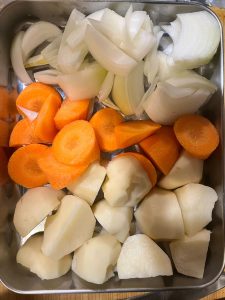
- Next, add oil and fry the garlic to release its aroma.
Then add onion and beef and saute. When the onions become transparent and soft, transfer everything to the pot.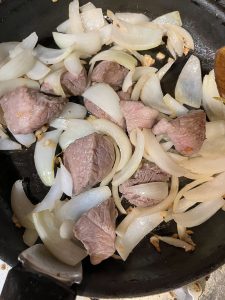
- Fill the pot with water, add the bay leaves, and simmer over low heat for 1 hour.
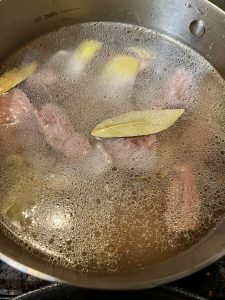
- Meanwhile, put oil in a frying pan and fry potatoes and carrots. They do not need to be properly cooked. If you think the surface of the potatoes is a little rounded, that’s it.
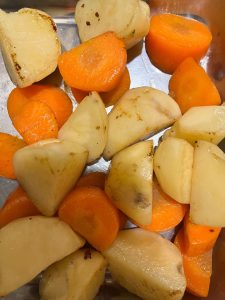
- When the pot has been cooking for one hour, add the fried carrots and potatoes to the pot and cook for another 20 minutes.
When the potatoes are firm enough to eat, turn off the heat.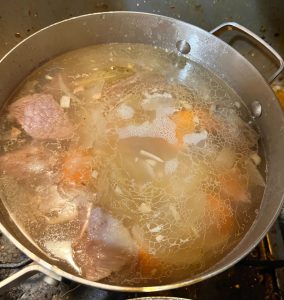
- One box of curry roux ingredients usually makes about 5-6 servings.
The trick is to add 1. S&B, 2-1, and 2-2 in 1/2, 1/4, and 1/4 portions, respectively.
Crumble the curry roux (it doesn’t have to be crushed, but it makes it easier to mix) and add to the pot to dissolve.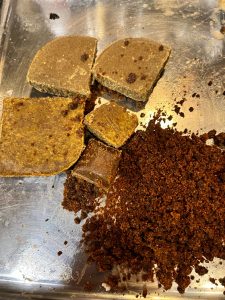
- Once curry roux is melted, simmer from there for 10 minutes, and stir a couple of large spoons of cheese powder (Parmigiano) at the end.
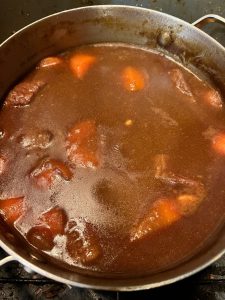
As a Japanese, I recommend eating it with rice, but I think it can also be served with bread or naan.
That’s all I wrote about the Japanese curry culture. If there is anything you want to know, please feel free to comment!
Abayo!
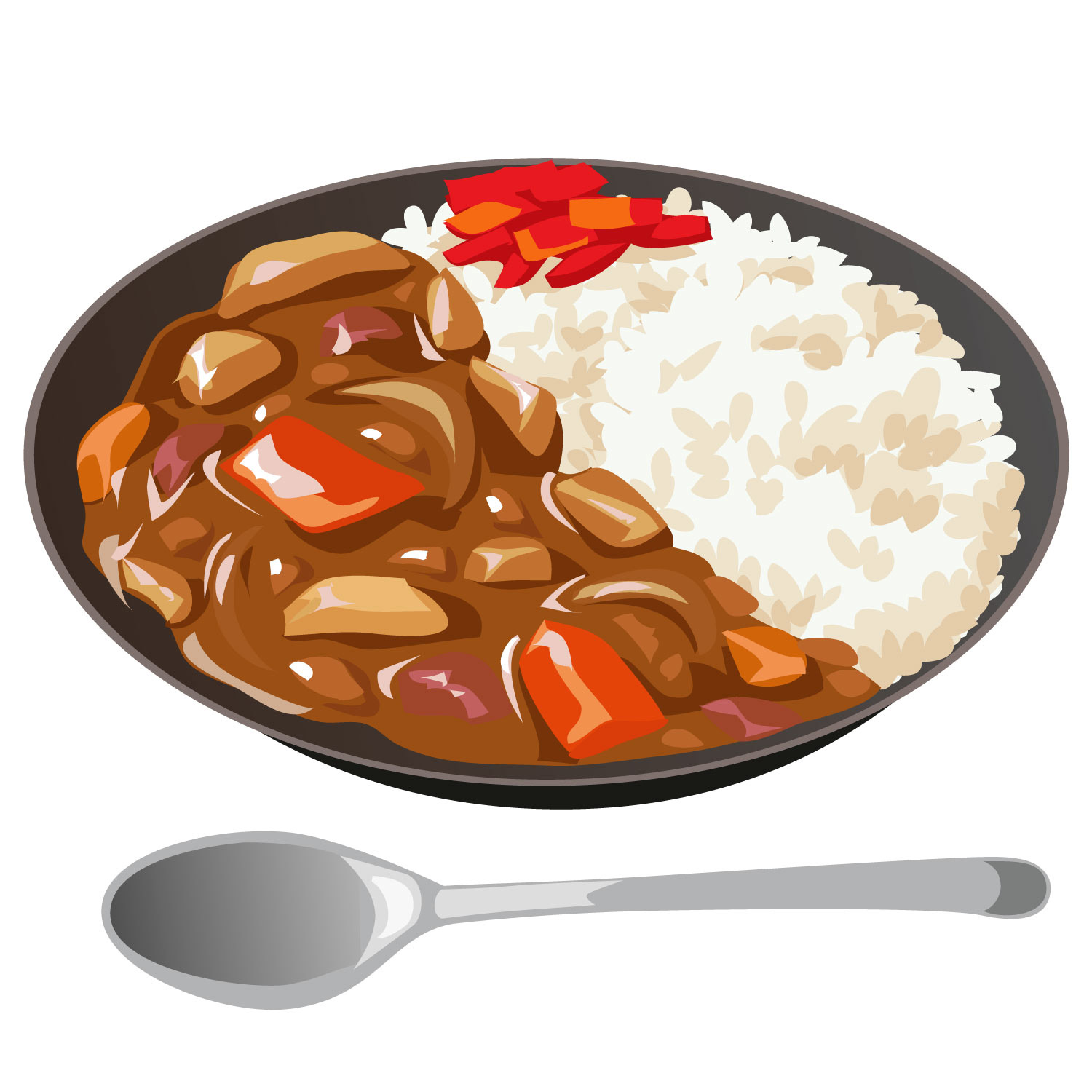
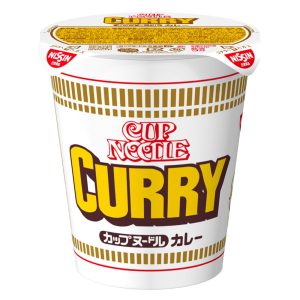


Comments